5 business continuity principles adopted by leading outsourcers

This article is a submission by Xceed. Xceed is a global provider of quality, multi-lingual Business Process Outsourcing (BPO) services.
The end is hopefully in sight regarding the COVID-19 pandemic.
Vaccination programs are being rapidly rolled-out, lockdown regulations are relaxing, and there is activity in streets, parks, and beachfront. Although, the global economy is still in a state of flux and will be for some time.
Emerging from the aftershock arise new, unexpected, innovative business trends that can lead to business recovery.
The 2021 Global CxO Business Continuity and Evolving Work Models for Outsourcers by Knowledge Executive, Ryan Strategic Advisory and CxOutsourcers provide insights into the prevailing trends and business best practices from a customer experience (CX) and business process outsourcing (BPO) delivery hub context.
5 business continuity principles adopted by outsourcers:
Here are five business continuity best practices and principles organizations are deploying:
1. Responding swiftly to disasters or pandemics and continuing to provide essential services
If the COVID-19 pandemic taught the business world something, it was responding promptly to disaster-related curveballs.
Regarding business continuity practices that have already been implemented, most of the survey’s respondents deployed data center continuity plans. Remote/mobile workforce and working-at-home-agent (WAHA) were also core focus in business continuity amongst global outsourcers.
Working from home (WFH) models are an intervention that has swept across all sectors globally and is a dominating trend of business, including with Egyptian outsourcers such as Xceed.
The figure below reveals the agile interventions outsourcers have implemented and plan to implement to support business continuity.
What agile business continuity and contact center recovery initiatives has your organization deployed or plans to deploy over the next 12 months?
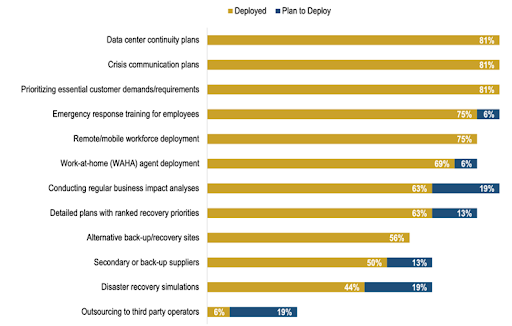
The graph also indicates how the customer was a major focus. The prioritization of essential customer demands/requirements, as well as creating clear and concise communication with customers, have been crucial reaction tools to mitigate the pandemic-led disruption on CX.
Although, it is not the dominant business continuity and contact center recovery initiative going forward.
The top trending interventions over the next year are:
- Disaster recovery simulations
- Conducting regular business impact analyses
- Outsourcing to third-party operators.
2. Adapting alternative/remote and work-at-home models in tandem with on-premise models
During the COVID-19 pandemic, outsourcers have found that their operations performed well in the WFH transition.
As vaccination plans are rolled out and ‘’normalization’’ sets in, there will be a gradual return to onsite operations.
However, things will not be the same as they were pre-pandemic.
Survey data has indicated that operators will retain a hybrid model, where some agents will work remotely, while those considered essential will work onsite.
Outsourcers maintaining a blended working model will continue transitioning to cloud-based omnichannel solutions to support hybrid working models and digital transformation.
Operators have realized the cost benefits of having some agents WFH, as well as the benefit of having access to a global skills base.
Higher workforce productivity, reduced workplace density and better business continuity are other core factors cementing the adoption of hybrid work models amongst outsourcers.
3. Creating business continuity plans and processes for virtual and work-at-home environments
COVID-19 has altered the way in which we engage in the economy and society, impacting the way outsourcers communicate with customers and their workers.
Life has become more digitalized, significantly shifting towards online interactions like e-commerce.
As a result, outsourcers have deployed digital contact center channels and used unified agent communication tools to adapt to the new forms of digital customer engagement.
As time goes by and the hybrid model becomes more entrenched, operators are looking towards more advanced engagement platforms and technologies.
The utilization of chat and voice bots will be more common amongst operators over the next 12 to 24 months.
Other advanced technology that will emerge throughout contact centers will consist of artificial intelligence (AI) solutions to support agents. The virtualization of CX will also lead to using video chat services for customers.
The graph below illustrates current WAHA initiatives that are being used as business continuity best practice, as well as future deployment of WAHA trends and developments.
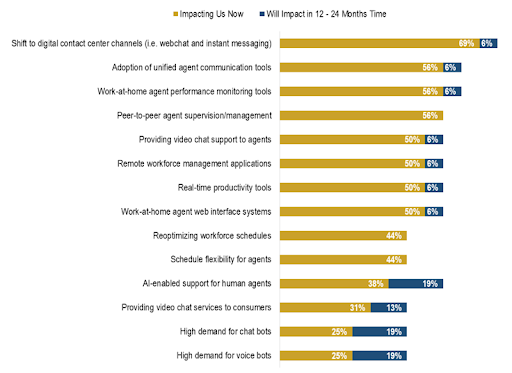
4. Utilizing always-on secure, cloud-based solutions
Cloud technology has been vital in supporting business continuity, especially from a WAHA perspective.
Cloud-based systems have enabled a smooth transition to a WAHA setup without negatively affecting employee performance, engagement, and collaboration.
Operators with cloud-enabled infrastructure, such as cloud-based telephony platforms, proved to have a distinct advantage when transitioning to a WFH environment and monitoring agents.
In addition, cloud solutions have offered critical layers of data protection and security, enabling outsourcers to meet regulatory and compliance standards during the pandemic, especially in a WFH context.
5. Formulating detailed crisis management plans with ranked recovery priorities
Long-term disruptions can occur without notice, compromising your CX operations. A clearly defined business continuity plan (BCP) can make a stressful experience manageable.
Respondents from the survey ranked various crisis management plans highly as business continuity and recovery initiatives for future deployment.
In addition to the business continuity measures mentioned in point one, emergency response training, alternative/backup recovery sites, and secondary or backup suppliers were rated as the top crisis management interventions.
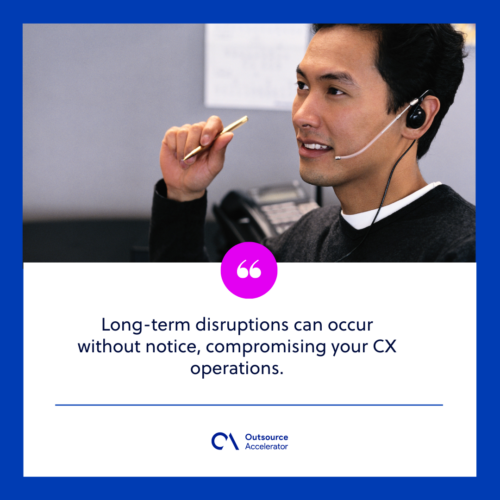
Coming up with a resilience strategy
One of the most notable indications from the analysis is that WAHA models as a business continuity best practice have been prolific in molding future trends in the CX contact center environment.
“The WAHA catalyst brought the rapid adoption of new technologies and digital infrastructure, particularly cloud-based solutions,” says Rasha Ezz El-Din Mohamed, Sales and Marketing Director of Egyptian BPO/ITO outsourcer, Xceed.
“AI, digital contact center channels, and productivity and staff management tools are the most common digital technologies that have and will continue to be rolled out in CX delivery hubs.”
Planning for a crisis is also something that Ezz El-Din Mohamed points out as a new yet vital action in the CX contact center industry.
Xceed deployed their ‘Xceed Resilience Strategy,’ a business continuity plan developed in the early stages of the pandemic to ensure the safety of their employees and business continuity.
WFH was one of the main interventions of the Xceed Resilience strategy, where over 8,000 employees shifted to remote working. A ‘Work from Hotel’ model was implemented for over 700 employees serving specific clients in Morocco and Egypt whose requirements did not allow for WFH agents.
Interestingly, for those remote-working employees, Xceed noticed lower levels of agent attrition and higher adoption of split shifts.
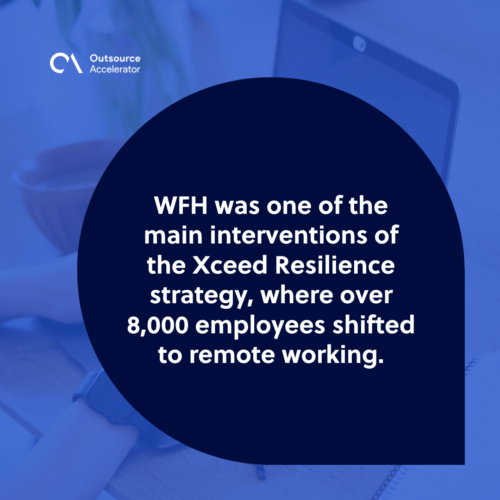
For agents that needed to be onsite, work areas were physically restructured to ensure social distancing, where mask-wearing was compulsory.
Data protection was another priority area, where the organization ensured global data protection and security standards were consistently being met.
Based on the above precautions, Xceed maintained business continuity to date without any risk of interruption of its operations nor impacting employees’ job security.
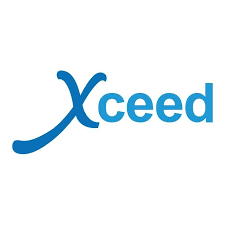






 Independent
Independent




